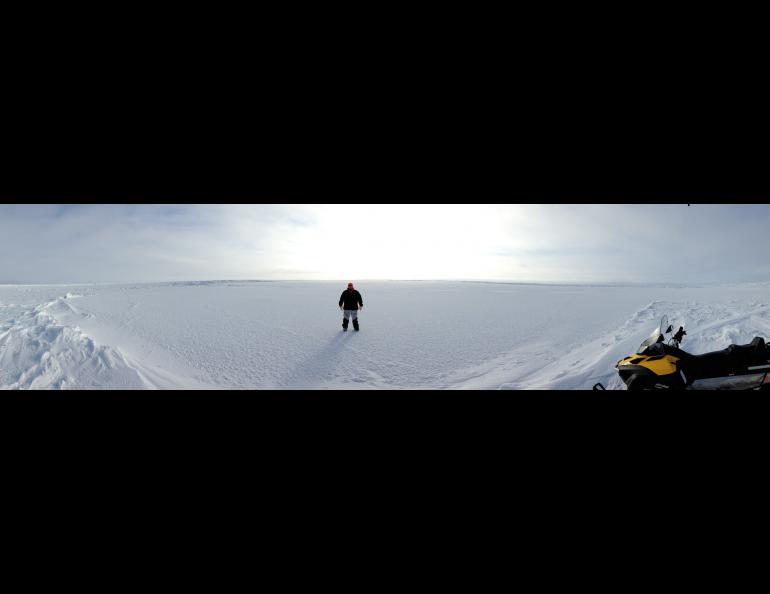

Barrow: Spring is in the air and in the ice
On the 5-mile snowmachine ride up to Point Barrow, we saw several fresh polar bear tracks the size of dinner plates, a pile of whalebones from last year, and a 3-foot-wide crack in the sea ice that could swallow a sled. The crack was created when an ice floe in the open water crashed into shore-fast ice.
It was masked in a snowdrift, and our guide Brower Frantz nearly fell into it.
Frantz’s job is to spot and avoid hazards like these. He is a bear guard and supervisor for UMIAQ.LLC, a Barrow-based company that provides field logistics to researchers and other groups. His task this week is to keep a group of University of Alaska Fairbanks researchers safe as they drill, slice, probe and travel on sea ice off the coast of Barrow.
Frantz can pick up tracks out of the corner of his eye while cruising on a snowmachine through a world of white.
“We grew up this way, and tracking is definitely one of the keys to success in our subsistence way of life. So tracking is one of our sixth senses, so to say,” Frantz said.
He also has a keen sense for ice, which is moving a lot this spring. That’s a big reason the UAF Sea Ice Field Course is in Barrow. Twenty-two graduate students and seven instructors (from Alaska and around the world) are up here for 10 days practicing the key field techniques used to study sea ice.
The snow and subzero wind chill doesn’t stop the science. Bright jackets pop against the ice about 100 yards off shore as students learn techniques like ice core sampling, measuring snow depth and finding the electric conductivity of the ice. These tests yield data on the thickness, temperature, salinity and microstructure of the ice, which can be plugged into a bigger portrait of how sea ice is changing.
One obvious change is that shore-fast ice is getting thinner and breaking up earlier in the year (as well as freezing up later). Through the 1980s, the ice used to be solid from November through June or July. Locals could go whaling and travel between coastal communities without worrying about falling in a crack or floating away on a broken slab of ice. Now there’s a large gash in the ice shelf in front of town, only a few hundred feet from shore.
“That’s the first time I’ve seen open water so early in the year, in mid-March. That was definitely an eye-opener,” Frantz said.
Last week, a whaling crew was nearly stranded when an opening (called a lead) formed between them and the shore. They managed to cross the big crack, plus 10 smaller ones, on snowmachines to get back to safety, and the ice was evacuated for the day. These events could become more common as the ice becomes less stable.
Frantz says sea ice research can add detail to the history and trends that locals are already seeing. And he enjoys being a part of it: snowmachining on the beach, tundra and ocean, setting up camps and supporting groups on the ice.
“At some point I can’t believe I’m getting paid for this.”
When he isn’t protecting scientists, Frantz is soaking up spring in Barrow.
“You go from almost a dormant stage due to the complete darkness for a couple of months, and then you get pure light throughout the summer. It’s the funnest time of the year.”
Geese and ducks are migrating through Barrow, and hunters head inland for the weekend to bring home fresh meat and eggs.
“If it’s not going to disturb the whalers, we’ll sometimes go out on lunch break and wait for a couple flocks to fly by and we’ll get provided with a duck dinner,” Frantz said.
As I leave Barrow, spring continues to chip away at winter.
The sun sets at 2 a.m. and rises an hour later. Flocks of eider ducks shoot across the sky every 10 minutes en route to Canada. Whaling crews are camped at the edge of the Chukchi sea ice watching for bowheads. School is ending, and kids wearing only sweatshirts are riding their bikes through mud puddles and catching a few last sled runs.
Since the late 1970s, the University of Alaska Fairbanks’ Geophysical Institute has provided this column free in cooperation with the UAF research community.






